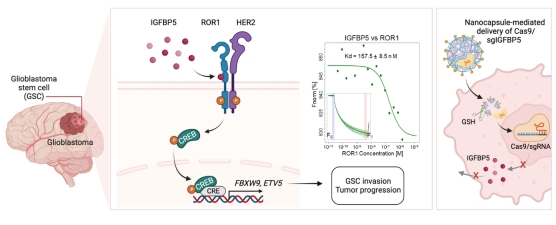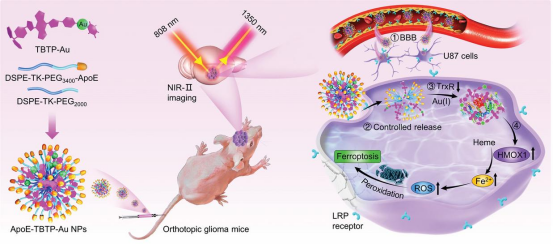Henan Key Laboratory of Brain Targeted Bio-nanomedicine, Henan University, focuses on the research of complex brain diseases (such as brain cancer, neurodegenerative diseases, etc.). After several years of development, it has condensed three research directions: molecular mechanism of brain diseases, intelligent nanodiagnostic technology and nano drug targeted therapy. Recently, the laboratory has made a series of research progress in the above three directions:
Progress I:New targets of glioma invasion and targeted therapy

Diffuse infiltration is the main reason for therapeutic resistance and recurrence in glioblastoma (GBM). Glioblastoma stem cells (GSCs) are believed to be responsible for GBM development, progression, invasion, recurrence, and therapeutic resistance. Nevertheless, the detailed molecular mechanisms of these invasive GSCs remain largely unexplored. Here, Prof. Yin’s team found that Insulin-like Growth Factor-Binding Protein 5 (IGFBP5) is a ligand for Receptor tyrosine kinase like Orphan Receptor 1 (ROR1), as a promising target for GSC invasion. GSC invasion capacity was inhibited by IGFBP5 knockdown and enhanced by IGFBP5 overexpression both in vitro and in vivo, particularly in a patient-derived xenograft model. Mechanically, we demonstrated that IGFBP5 binded to ROR1 can promote the formation of ROR1/HER2 heterodimers, induce phosphorylation of CREB and regulate the expression of ETV5 and FBXW9 at the transcriptional level, thereby promoting GSC invasion and tumorigenesis. At the same time, the team used a tumor-specific targeting and penetrating nanocapsule-mediated delivery of CRISPR/Cas9-based IGFBP5 gene editing which significantly suppressed GSC invasion and downstream gene expression, prolonged the survival of GBM in situ tumor-bearing mice. Collectively, the team found that IGFBP5 regulates the invasion of GBM through the ROR1/HER2-CREB signal axis, which provides new therapeutic targets and ideas for GBM treatment.
The research results was published entitled as “IGFBP5 is an ROR1 ligand promoting glioblastoma invasion via ROR1/HER2-CREB signaling axis” in Nature Communications (IF=17.694). Ph.D. candidate Rui Niu, Prof. Yan Zou from HENU and Weiwei lin, Seong-Min Park, Sung Soo Kim from KNCC shared the first authors. Prof. Bingyang Shi and Prof. Jinlong Yin from HENU and Prof. Jong Bea Park from KNCC shared the co-corresponding authors.
Progress II:mRNA nanomaterials for brain glioma

Phosphatase and tensin homolog deleted on chromosome 10 (PTEN) is a common tumor suppressor gene that plays an important role in the initiation and progression of glioblastoma (GBM). Loss of PTEN activity in GBM patients is associated with treatment resistance, tumorigenesis, and poor prognosis. Messenger RNA (mRNA) has recently shown promise in treating various brain diseases. However, the properties of mRNA (e.g., instability, poor targeting, inability to cross the blood-brain barrier, etc.) seriously hinder the application of mRNA in GBM. To solve these problems, our laboratory designed a new mRNA nanomedicine (ABNPs@mRNA), which can effectively solve the current challenges of mRNA. The new mRA nanomedicinehas the following characteristics:
(1) The modification of ApoE peptide can greatly improve the accumulation of drugs in the brain tumor.
(2) Biomimetic strategies based on cell membranes can effectively achieve immune escape in the body.
(3) The characteristics of tumor microenvironment response can promote the efficient release of mRNA in the tumor site. The biomimetic nanomedicine had good therapeutic effect in U87MG and CSC2 GBM stem cell in situ tumor-bearing mouse models, which could significantly inhibit tumor growth and prolong the survival time of mice without obvious toxic side effects. This biomimetic nanomedicine provides new ideas for gene therapy of GBM.
The research results was published entitled as “Non-invasive PTEN mRNA brain delivery effectively mitigates growth of orthotopic glioblastoma” in Nano Today (IF=18.962). Dr. Yanjie Liu and Ph.D. candidate Dongya Zhang shared the first authors. Prof. Bingyang Shi, Prof. Yan Zou and Prof. Meng Zheng shared the co-corresponding authors.
Progress III:AIE Lights up glioma visualization Therapy

Ferroptosis, a newly programmed cell death paradigm, is expected to provide a new opportunity for the safe and efficient theranostic of glioma. However, the current ferroptosis agents lack effective in vivo tracer function and only have low specific activation efficiency. NIR-Ⅱ (1000-1700 nm) aggregation-induced emission (AIE)-based in vivo fluorescence imaging has the advantages of deep-penetration, aggregation-enhanced emission, high signal-to-noise ratio, and real-time imaging. It is an advanced technique for monitoring the in vivo metabolism and distribution of nano-drugs. Based on the merits of AIE and the feature of glioma, we developed a brain-targeted ferroptosis agent with NIR-Ⅱ fluorescence imaging and Au (I) active center for highly specific ferroptosis for the first time. The system not only effectively monitored the BBB penetration and in vivo distribution of nano-drugs, but also specifically activated the TrxR-HMOX1-mediated ferroptosis pathway by targeting the thioredoxin reductase (TrxR) that is highly expressed in glioma. After effective inhibition of GBM, it greatly prolonged the survival of glioma-bearing mice. This study provides an important reference for the development of next-generation advanced visual nanodrugs.
The research results was published entitled as “A Brain-Targeting NIR-II Ferroptosis System: Effective Visualization and Oncotherapy for Orthotopic Glioblastoma" in Advanced Science (IF=17.521). Prof. Jing Zhang from SMU and master student Lulu Han from HENU are co-first authors. Prof. Benzhong Tang, Prof. Bingyang Shi, Associate Prof. Jiefei Wang and Prof. Lei Zheng areco-corresponding authors.
Henan Key Laboratory of Brain Targeted Bio-nanomedicine is supported by the College of Life Science and the College of Pharmacy, Henan University. In September 2015, the laboratory was established as HENU-MQ Joint Center of Biomedical Innovation, and was subsequently approved as Nano Biomedical International Joint Laboratory of Henan Province in 2016, Bio-Nano Medicine Disciplinary Innovation and Talent Introduction Center of Henan Province in 2018. It was then designated as a Key Laboratory of Henan Province in 2020 after receiving approval from the Department of Science and Technology.
The lab's work concentrates on understanding the mechanisms behind brain disorders, creating novel diagnostic and therapeutic approaches. A series of research results have been achieved in developing targeted therapies for brain disorders, investigating new therapeutic targets and delivery mechanisms, development and application of brain diagnosis and treatment system, brain delivery system Construction, preclinical evaluation and translation of brain-targeted nanomedicines. This has effectively supported the construction of " First-Class Discipline" - biology of HENU, promoting the integration of biology and related disciplines and the development of " Biology plus".
Paper link:https://www.nature.com/articles/s41467-023-37306-1
https://doi.org/10.1016/j.nantod.2023.101790
https://doi.org/10.1002/advs.202206333

 News /
Content
News /
Content


